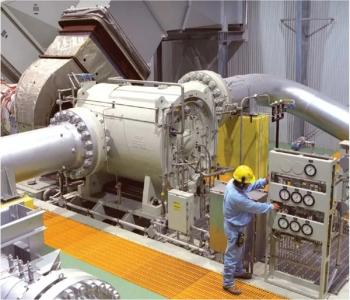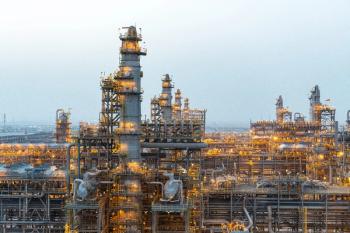
- November/December 2024
- Volume 65
- Issue 7
Transitioning to Hydrogen-Powered Thermal Power Plants: Opportunities and Challenges
The future of hydrogen in power generation depends on the successful integration of technology, infrastructure, and regulatory measures.
According to the International Energy Agency (IEA), decarbonizing the global power generation sector can be achieved by significantly increasing the share of renewable energy sources (RES), such as wind and solar. However, these renewable sources provide a fluctuating supply of electricity that must be balanced by other forms of reliable, affordable, and sustainable power generation. The IEA estimates that 8 MT per year of low-carbon hydrogen will be used globally for power generation by 2030 and 88 MT per year by 2050. This is a significant scale-up in hydrogen use for power generation as the amount required by 2050:
- equals the total amount of all hydrogen production globally in 2020; and
- represents 17% of all low-carbon hydrogen production by 2050.
In IEA’s Global Hydrogen Review, the agency identifies low-carbon hydrogen as a driver of the clean-energy transition.
Gas turbines already fulfill the crucial balancing role in the energy system. Their role in a changing electricity grid, dominated by fluctuating RES, is shifting from baseload operation to peaking applications and grid services. By extending their fuel capabilities to include low-carbon hydrogen, gas turbines can contribute during the energy transition period and in long-term energy strategies. Effectively, the value of generation is expected to move toward dispatchable power providers. In this scenario, hydrogen gas turbines will be one of the carbon-neutral technologies supporting society in achieving ambitious energy and climate targets, as discussed in
PRE-CONDITIONS FOR HYDROGEN POWER PLANTS
Deploying hydrogen power plants requires certain conditions to ensure the effective and sustainable use of hydrogen as a fuel. Great progress has been made in recent years, but some technical challenges still need to be addressed. Four key areas have been identified.
Large-scale hydrogen production. Green hydrogen can be produced via water electrolysis using surplus renewable electricity. While there is a strong development regarding higher efficiency, lower production costs, and longer lifetimes, standard electrolyzers available today have a conversion efficiency of about 65%.
GREEN HYDROGEN PROJECT EXAMPLES
- 🇳🇱 RWE: Eemshydrogen in the Netherlands: 50 MW electrolyzer
- 🇳🇱 Vattenfall: Ijmuiden Ver Beta in the Netherlands: 2 GW wind and 50 MWp solar combined with <1 GW electrolyzer
- 🇩🇪 Uniper Energy Park Bad Lauchstädt in Germany: 30 MW electrolyzer combined with storage
Blue hydrogen is produced through methane reforming with carbon capture. The typical efficiency for these processes is around 70% (lower heating value). While the reforming step is mature technology, the combination of carbon capture and storage is still under development. However, the first demonstration projects showed feasibility.
BLUE HYDROGEN PROJECT EXAMPLES
- 🇳🇱 H-Vision in the Netherlands): two plants of 750 MWH2, initial feedstock will be refinery gases
- 🇳🇱 H2M in the Netherlands: 1 GWH2, feedstock natural gas
- 🇩🇪 BlueHyNow in Germany: 600 MWH2, feedstock natural gas
Extensive hydrogen transportation infrastructure. A pipeline infrastructure is needed for the hydrogen supply of larger power plants. The European Hydrogen Backbone, for example, plans to establish over 31,500 km of hydrogen pipelines by 2030, connecting key industrial clusters, production sites, and storage facilities. The project aims to retrofit existing natural gas pipelines to transport hydrogen, providing a cost-effective solution for building a comprehensive hydrogen network.
In 2018, Hynetwork in the Netherlands converted a 12-km natural gas transport pipeline for hydrogen use and kicked off commercial hydrogen operation between the Dow and Yara chemical plants with plans to extend this approach across Europe.
Options for hydrogen storage. Green hydrogen production is subject to fluctuations in renewable energy availability, making consistent supply challenging without adequate storage. On the other hand, blue hydrogen production is a continuous process but is not aligned with the demand profiles of flexible power generation. Therefore, hydrogen storage solutions are critical for buffering mismatches between production and consumption. In terms of cost, storage systems based on pressure vessels or multi-tube arrangements are only suitable for small- to mid-sized peak-load gas turbine power plants. Underground salt caverns offer the most promising option for large-scale hydrogen storage for mid-merit and large gas turbines. The total technical storage potential across Europe is estimated at 85 PWhH2.
Hydrogen as a commodity. Developing a full-scale hydrogen market requires clear regulations, business models, and financial incentives that promote investing in hydrogen production, storage, and transportation. South Korea launched one of the world’s first clean-hydrogen power generation tenders, enabling up to 6,500 GWh/year of electricity produced from clean hydrogen with 15-year contracts. In Europe, the H2Global Foundation is using auction-based mechanisms and subsidies to balance the difference between supply and demand prices for hydrogen, thus enabling a market ramp-up.
HYDROGEN COMBUSTION
Combusting hydrogen in gas turbines poses several technical challenges due to hydrogen’s unique physical and chemical properties. Hydrogen’s higher flame speed, lower ignition energy, and higher diffusivity compared to natural gas increase the risks of combustion issues, such as flashback, thermoacoustic instabilities, and elevated NOx emissions.
Hydrogen combustion systems can generally be categorized into diffusion flames with dilution and lean premixed systems. Diffusion flames involve the direct combustion of hydrogen using diluents, such as nitrogen or steam, to control flame temperatures and reduce NOx emissions. While this approach allows for burning up to 100% hydrogen, it introduces additional system complexity, reduces efficiency, and can be costly due to the need for diluent injection systems.
Lean premixed combustion technology, on the other hand, has the potential to significantly reduce NOx and carbon emissions without using diluents by thoroughly mixing air and fuel before ignition, resulting in lower combustion temperatures. However, lean premixed technology developments are still ongoing to enable high hydrogen blends or pure hydrogen capability. Current gas turbines can already accommodate hydrogen blends up to 30 - 50% for heavy-duty engines (e.g., H-class or F-class), 50 - 75% for small to medium gas turbines (e.g., industrial gas turbines and aeroderivative gas turbines), and 20% for micro gas turbines, although this can vary by OEM.
Lean premixed combustion technology has the potential to significantly reduce NOx and carbon emissions without using diluents by thoroughly mixing air and fuel before ignition, resulting in lower combustion temperatures. However, lean premixed technology developments are still ongoing to enable high hydrogen blends or pure hydrogen capability.
The various ranges of maximum hydrogen content are related to different firing temperatures and combustion technologies, such as micro-mixing, swirl-stabilized, jet-stabilized, axial-fuel staging, or combinations of these technologies. Developing combustion systems that can operate across the full range of blends up to 100% hydrogen is ongoing. Many OEMs are developing 100% hydrogen-capable dry low emissions (DLE) systems for availability by 2030. However, a DLE combustion system capable of handling pure hydrogen is not currently commercially available. Additional R&D activities to achieve this target are ongoing and further efforts will be needed.
HYDROGEN INTEGRATION INTO THERMAL POWER PLANTS
Integrating hydrogen into existing thermal power plants presents an opportunity to reduce carbon emissions while leveraging established infrastructure.
Retrofitting gas turbines to burn hydrogen requires modifications to the fuel delivery systems, combustion chambers, and control mechanisms. This approach minimizes capital expenditure (CapEx) and facilitates the transition to a hydrogen-based energy system by utilizing the existing assets. In general, smaller gas turbines with a lower efficiency are easier to modify, as there is a substantial margin to the limits of the materials and components used. However, conversion can become costly or even uneconomical for engine-specific reasons.
Most existing gas turbines can co-fire natural gas with hydrogen blending up to 30% with existing DLE burner hardware and higher hydrogen contents in conventional diffusion combustion systems. Blends with up to 60% hydrogen are necessary to comply with the latest European Union taxonomy. As today’s burner technology (which is most of the installed capacity) will show increased NOx emissions with the addition of hydrogen, measures are likely needed to meet the environmental regulations, like installing selective catalytic reduction (SCR) units, derating the power output, or combustion dilution with water, steam, or nitrogen. In this case, CapEx may be similar to a complete retrofit for up to 100% hydrogen. However, OEMs and third parties are developing and demonstrating new retrofittable, fuel-flexible burners that could control NOx emissions across the full range of hydrogen blends.
Changes in the exhaust gas composition mainly impact hydrogen utilization on downstream components. Specifically, the exhaust-gas water content rises with the increasing amount of hydrogen in the fuel and decreasing global air-to-fuel ratio. This is particularly important in combined-cycle configurations where heat recovery steam generators must be adapted to prevent condensation and corrosion. Adapting the SCR unit might be necessary to mitigate increased NOx emissions.
When adding hydrogen to fuel, either as a blend or up to 100%, the safety of the gas turbine enclosure and equipment is also a consideration. Gas leaks in the enclosure should always be avoided, and all materials in the gas service should be checked for hydrogen compatibility.
New-build power plants designed to initially operate on hydrogen can incorporate the latest advancements in materials and cooling technologies, ensuring components can withstand the demanding conditions of hydrogen combustion. While no large-scale examples of 100% hydrogen-powered plants are in operation today, the concept of “hydrogen-ready” power plants is gaining traction. These plants are designed with the flexibility to transition from natural gas to hydrogen as infrastructure and market conditions evolve.
ACHIEVEMENTS AND ONGOING DEVELOPMENTS
The entire value chain of the turbomachinery industry prioritizes the decarbonization of gas turbines, which aligns with the climate-neutral policies being implemented in Europe, North America, and Eastern Asia. Significant progress has been made in developing and deploying hydrogen gas turbines, with efforts spanning from fundamental research to real-world demonstration projects. Industry stakeholders, supported by government funding and academic research, are advancing hydrogen combustion technologies and developing hydrogen infrastructure.
Pilot projects across Europe, North America, and Asia have successfully demonstrated the feasibility of using hydrogen blends in gas turbines. FIGURE 1 provides an overview of major research and development projects for hydrogen combustion for gas turbines. For example, the HYFLEXPOWER project in France showcased Siemens Energy’s SGT-400 gas turbine running on 100% hydrogen, illustrating the viability of adapting existing technology to zero-carbon fuels. Demonstrations serve as a blueprint for future projects and provide valuable insights into the operational requirements for hydrogen-powered gas turbines. However, further development efforts are ongoing to derive technical solutions concerning the challenges associated with high hydrogen content in the fuel.
HYDROGEN'S POTENTIAL FUTURE
Transitioning to hydrogen-fueled thermal power plants is a critical step toward achieving a carbon-neutral energy system. Gas turbine technology is positioning itself as an important and technologically mature building block for dispatchable power and grid stability to complement variable renewable energy sources. Moreover, the possibility of adapting existing gas turbine assets and infrastructure to use hydrogen can drastically reduce the carbon footprint of power generation as well as other gas turbine users (e.g., oil and gas, cogeneration, compressor stations, maritime transport, etc.) in the short-term to support the energy transition.
To fully unlock the potential of zero-emission hydrogen gas turbine technology, research and development activities are needed to overcome combustion instabilities and further develop (premixed) combustion technologies maintaining low NOx emission for up to 100% hydrogen. Changes in the hot-gas properties for hydrogen combustion also require developing new materials and cooling technologies for hot-gas-path components. The deployment of new technology in a real-world environment will be important to address in the demonstration phase.
The next step is to develop adapted operating concepts, regulations, and financial models for future energy systems so that hydrogen gas turbines can fulfill their role. The future of hydrogen in power generation depends on the successful integration of technology, infrastructure, and regulatory measures. With strong industry commitment and continued collaboration across sectors, hydrogen gas turbines are poised to play a central role in the energy transition, paving the way for a sustainable and resilient energy future.
REFERENCES:
- International Energy Agency (IEA). Net Zero by 2050. Paris, France: International Energy Agency, 2021
- Ibid.International Energy Agency (IEA). Net Zero by 2050. Paris, France: International Energy Agency, 2021
- International Energy Agency. Global Hydrogen Review 2023. Paris, France: International Energy Agency, 2023.
- Gasunie. Gasunie hydrogen pipeline from Dow to Yara brought into operation. November 18, 2018.Hydrogen pipeline in the Netherlands
- Cagalayan, D.G., Weber, N., Heinrichs, H.U., Linßen, J., Robinius, M., Kukla, P.A., Stolten, D. Technical potential of salt caverns for hydrogen storage in Europe. 11, February 28, 2020, International Journal of Hydrogen Energy, Vol. 45, pp. 6793-6805.Options for hydrogen storage
- Min-gyun, K. 2024년 청정수소발전시장 경쟁입찰 공고 (2024 Clean Hydrogen Power Generation Market Competitive Bidding Announcement). South Korea: Korea Power Exchange, May 24, 2024.South Korea clean hydrogen
- ] H2Global Stiftung. H2Global Foundation. Hamburg, Germany: H2Global Stiftung, 2024.Hydrogen as a commodity
- Wezel, R. and Barón, S.C. The Turbine Industry Commits to Provide Europe with ‘Renewable Gas-Ready’ Turbines. Mechanical Engineering. New York, New York: American Society of Mechanical Engineers, September 2019. Vol. 141, 9, pp. 56-57.Dry low nox 100% hydrogen
- TÜV SÜD Industrie Service GmbH. H2-Readiness of Combined Cycle Power Plants. Munich, Germany: TÜV SÜD Group, March 2023. S-MKG/PWS/816.0/en/DE.Hydrogen-powered plants is gaining traction
- Parsania, N., Hermeth, S., Witzel, B., Yilmaz, E., Fourcade, S., Garmadi, S., Trump, H., McCaig, P. HYFLEXPOWER Project: Demonstration of an Industrial Power-to-H2-to-Power Advanced Plant Concept With Up to 100% H2 in an SGT-400 Gas Turbine. London: American Society of Mechanical Engineers, 2024. Proceedings of the 2024 ASME Turbo Expo: Turbomachinery Technical Conference and Exposition. GT2024-124016.
About the Authors
Peter Kutne is Head of the Department Gas Turbines at the Institute of Combustion Technology of the German Aerospace Center (DLR).
Giuseppe Tilocca is a Scientific Officer at ETN Global.
Articles in this issue
10 months ago
Myth: Hydrogen Handling is Effortless12 months ago
Turbomachinery International: November/December 2024Newsletter
Power your knowledge with the latest in turbine technology, engineering advances, and energy solutions—subscribe to Turbomachinery International today.





